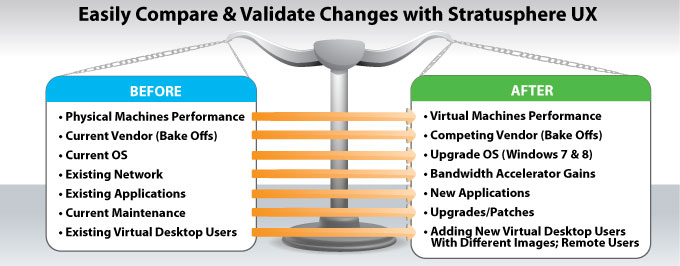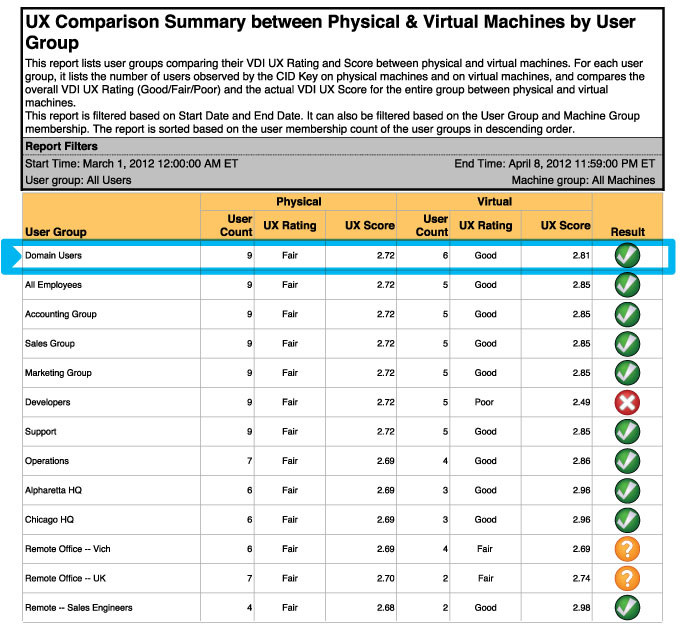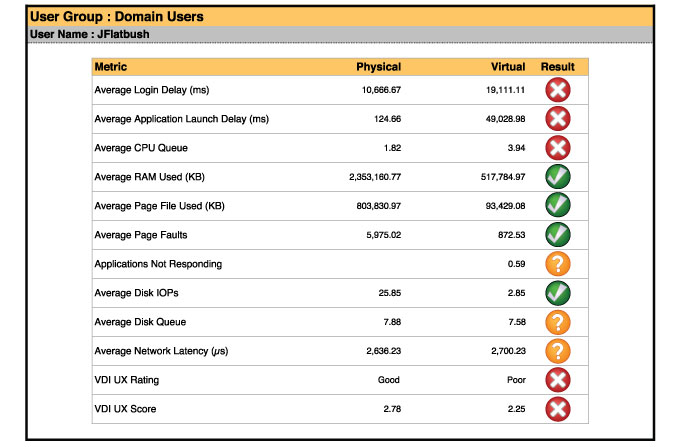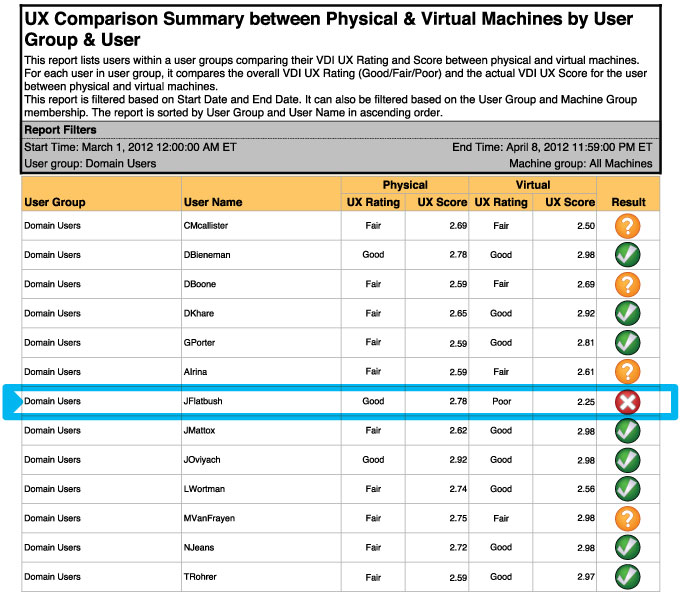Before / After Comparisons with Stratusphere UX for Optimum Decision-Making
Desktop virtualization is a real option for more and more companies who want to lower operating costs, simplify management, and enhance productivity, security and desktop mobility. However, the reality is that – on average – roughly a quarter of all virtual desktop projects stall due to unacceptable end user performance and/or cost overruns. How do you keep your projects on track and your budgets in check? The answer is “user experience validation,” a process using Liquidware Labs Stratusphere UX solution.
What is User Experience Validation and Why Do You Need it?
User experience validation provides hard objective data to verify that you are making the right decisions at each phase of your project. User experience validation saves you time and money, and, more importantly, ensures users satisfaction and productivity on their virtual desktops.
User Experience Validation Cuts Through the Complexity and Uncertainty in Managing Virtual Desktop Environments
You can verify that you are on track to success by setting up progressive User Experience Validation Checkpoints for the following stages:
- During a proof-of-concept (POC) in order to ensure that vendors’ oofferings meet your requirements
- In “bake-offs” when evaluating competing products
- During pilots to ensure the user experience on virtual desktops meets or exceeds that of physical desktops
- During production, when scaling or changing the environment, to ensure that performance standards
- are maintained and adequate resources provided

Do You Need a User Experience Validation Solution?
The short answer is Yes! If you have performed an assessment with Stratusphere FIT, you already have a solid picture of your physical desktop environment. You can continue to ensure that virtual desktops perform to the same or better levels with Validation Checkpoints with Stratusphere UX. You can even compare your virtual desktop performance to existing concurrently running physical desktops to see which provide the better user experience.
Consult the brief questionnaire below to see whether or not you have the clear, detailed information you need to validate that your environment is performing to SLA requirements, and is meeting user expectations and TCO / budget goals.
- Can you pro-actively monitor physical and virtual desktops from a single pane-of-glass in order to validate they are performing on par with SLAs and to get alerts if issues develop with systems or users?
- Do you have remote users with different needs than in-office workers? Do workers follow different schedules and work patterns or do you have spikes when all / most are hitting the system?
- Are you planning an OS upgrade? Do you have a method to check that your applications are running well on the new OS after migration?
- Do you know how many different desktop images are needed to meet the requirements of your diverse workforce?
- Do you know which vendors’ solutions offer the best performance vs. cost for your environment? Do you have a way of getting hard comparison data in a bake off?
- Can you measure the impact of changes (adding users or adding, patching or upgrading applications) to your environment over time? Can you verify that you are maintaining user experience and performance after the change?
Validation-In-Action: Reports in Stratusphere UX
Once you perform an assessment with Stratusphere FIT you have a baseline for validating that your virtual desktop performance is on par with that of physical desktops. Stratusphere FIT and Stratusphere UX are purpose-built to provide this before-and-after comparison.
Stratusphere UX provides at-a-glance Validation Reports for a side-by-side comparison of physical and virtual machines. Stratusphere UX leverages a patented, intelligent framework that tracks hundreds of metrics in near real time. This sophisticated software performs intricate calculations that correlate metrics in order to extract meaningful ratings and scores of desktop performance to support informed decision making. No other product on the market offers the range or depth of virtual desktop environment metrics across user experience, end points, applications, machine and host resources, user authentication and authorization, desktop virtualization platform, server, storage and network.

Report 1: Stratusphere UX Comparison Summary between Physical and Virtual Machines by User Group (click image to enlarge)
In Report 1, you see all of the user groups in a virtual environment. Highlighted is one group “Domain Users.” A member of this group is complaining that he is having problems with his virtual desktop. Although the group has an overall GOOD rating, we can drill down to the see all users in the group, and then to the individual user level to validate each user’s experience.
Report 2: Stratusphere UX Comparison Summary between Physical and Virtual Machines by User Group & User (click image to enlarge)
In Report 2, we can get a better picture of how each user within the group experiences his or her virtual desktop and how it compares with his or her physical desktop. In the report above, most of the users have a GOOD experience that is within the desired performance thresholds. A few users with FAIR indicators should be checked out. But the complaining user does have a problem with a POOR rating. We can now take a deeper dive into his particular desktop (See Report 3 below.) to verify what the issues are and to identify possible remedies.

Report 3: Stratusphere UX Comparison Summary between Physical and Virtual Machines by Specific User Name (click image to enlarge)

